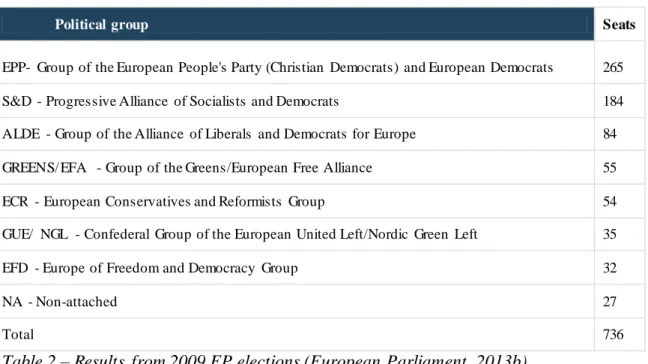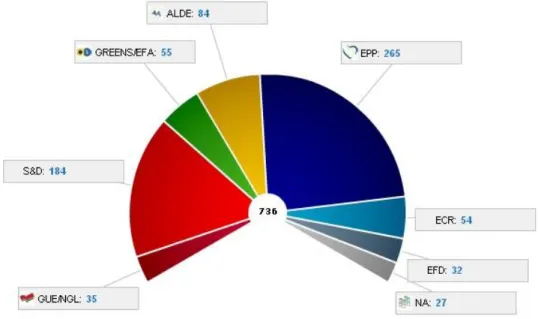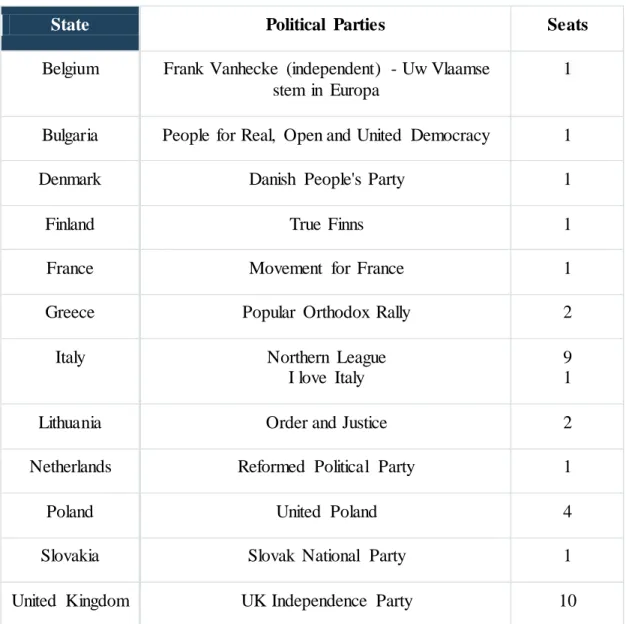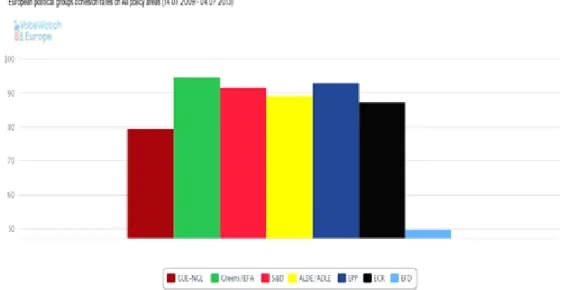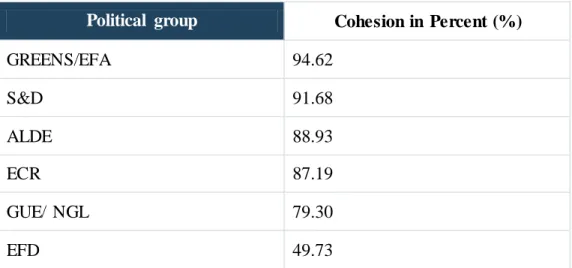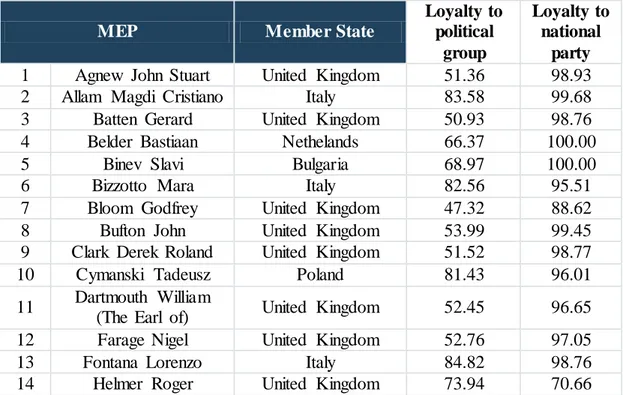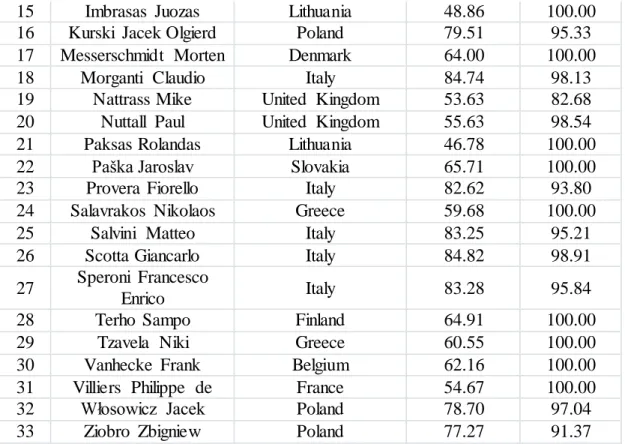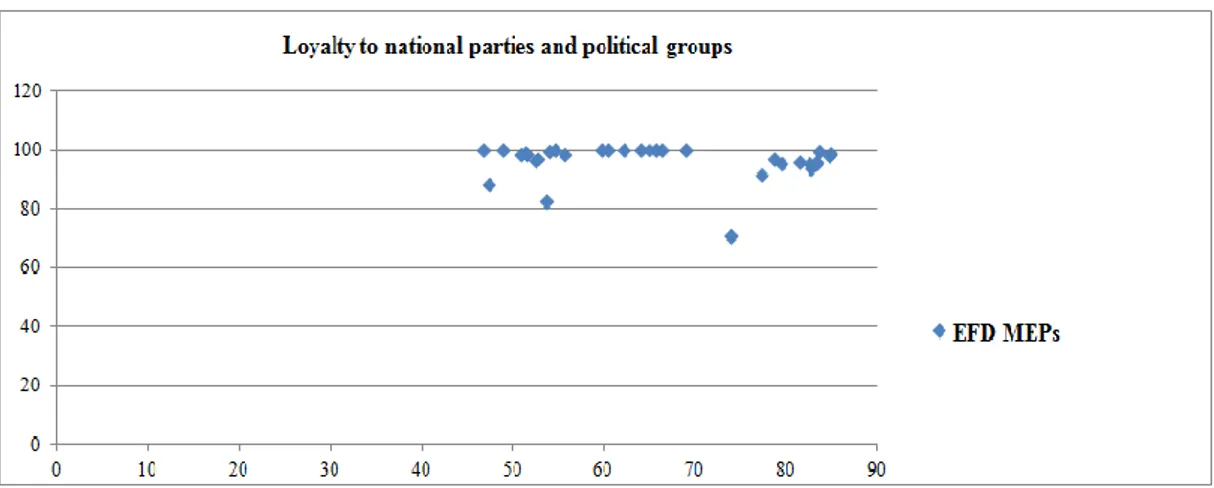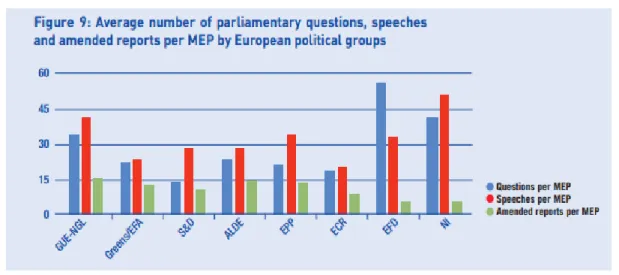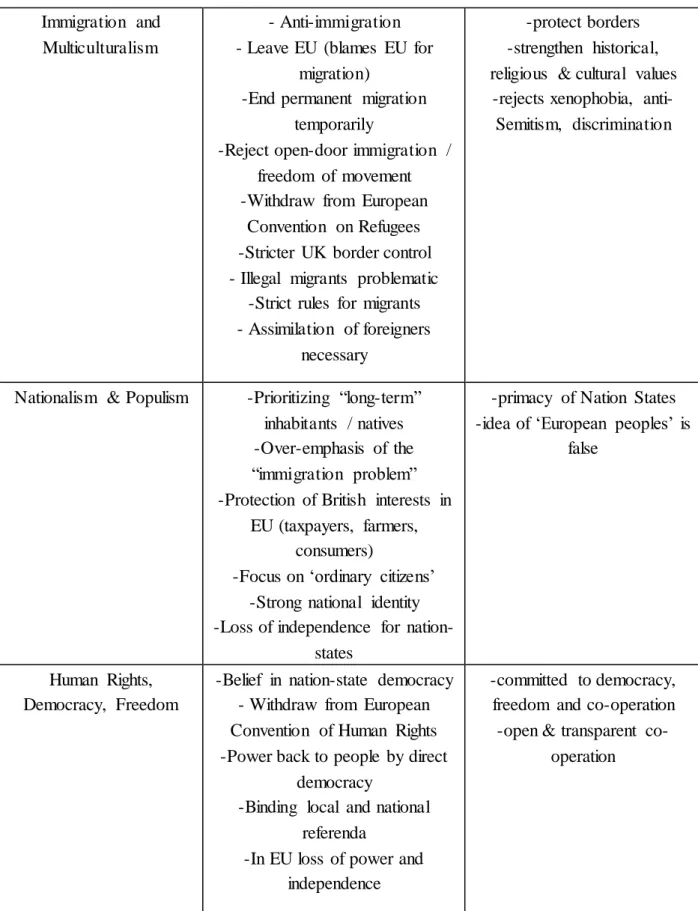CONTEMPORARY FAR RIGHT IN EUROPE AND
TRANSNATIONAL COOPERATION: CASE OF UK
INDEPENDENCE PARTY
A Master’s Thesis
by YUSUF GEZER
Department of International Relations İhsan Doğramacı Bilkent University
Ankara
CONTEMPORARY FAR RIGHT IN EUROPE AND
TRANSNATIONAL COOPERATION: CASE OF UK
INDEPENDENCE PARTY
Graduate School of Economics and Social Sciences of
İhsan Doğramacı Bilkent University
by
YUSUF GEZER
In Partial Fulfilment of the Requirements for the Degree of MASTER OF ARTS
in
THE DEPARTMENT OF INTERNATIONAL RELATIONS
İHSAN DOĞRAMACI BİLKENT UNIVERSITY ANKARA
I certify that I have read this thesis and have found that it is fully adequate, in scope and in quality, as a thesis for the degree of Master of Arts in International Relations.
--- Prof. Dr. Norman Stone
Supervisor
I certify that I have read this thesis and have found that it is fully adequate, in scope and in quality, as a thesis for the degree of Master of Arts in International Relations.
--- Asst. Prof. Dr. Clemens Hoffmann
Examining Committee Member
I certify that I have read this thesis and have found that it is fully adequate, in scope and in quality, as a thesis for the degree of Master of Arts in International Relations.
--- Assist. Prof. Dr. Ioannis N. Grigoriadis Examining Committee Member
Approval of the Graduate School of Economics and Social Sciences
--- Prof. Dr. Erdal Erel
iii
ABSTRACT
CONTEMPORARY FAR RIGHT IN EUROPE AND
TRANSNATIONAL COOPERATION: CASE OF UK
INDEPENDENCE PARTY
Gezer, Yusuf
M.A., Department of International Relations Thesis Supervisor: Prof. Dr. Norman Stone
September 2013
If and how far-right parties are able to come together and cooperate as a transnational movement within the EU? This thesis will try to understand how far-right parties in European Parliament come together and cooperate despite their nationalist agenda and what is this cooperation’s impact on politics in Europe. This thesis assumes that contemporary far-right parties discard nationalistic concerns and aspirations in favor of transnational cooperation. In accordance with this purpose, definitions of ideology, fascism and far-right will be defined and then these definitions would help to understand which parties could be accepted as far-right parties. After defining them, this thesis will examine underlying aspects of the transnational cooperation between far-right parties in Europe and try to determine how this transnational cooperation became reality despite far-right parties’ nationalistic stand. Furthermore,
iv
a case study will be conducted to understand what is a far-right party’s ideology and stance towards European Union in general.
Key Words: Contemporary Far Right, European Parliament, EFD, UK
v
ÖZET
AVRUPA'DAKİ MODERN AŞIRI SAĞ VE ULUSLARARASI
İŞBİRLİĞİ: BİRLEŞİK KRALLIK BAĞIMSIZLIK PARTİSİ VAKASI
Gezer, Yusuf
Yüksek Lisans, Uluslararası İlişkiler Bölümü Tez Yöneticisi: Prof. Dr. Norman Stone
Eylül 2013
Aşırı sağ partiler nasıl ve ne şekilde bir araya gelip uluslararası bir hareket olarak AB içerisinde hareket edebiliyor? Bu tez, aşırı sağ partilerin milliyetçi programlarına rağmen nasıl bir araya gelip işbirliği içerisine girdiklerini ve bu işbirliğinin Avrupa politikalarına etkisini anlamaya çalışacaktır. Bu tez, modern aşırı sağ partilerin milliyetçi kaygılarını uluslararası işbirliği için bir kenara bıraktıklarını varsaymaktadır. Bu amaç doğrultusunda, ideoloji, faşizm ve aşırı sağın tanımları yapılacak ve bu tanımlar hangi partilerin aşırı sağ olarak değerlendirilebileceğini anlamaya yardımcı olacaktır. Tanımlamaların ardından, bu tez aşırı sağ partilerin AB içerisinde yaptıkları uluslararası işbirliğinin altında yatan nedenleri ve bu işbirliğinin, aşırı sağ partilerin milliyetçi duruşlarına rağmen nasıl gerçekleştiğini araştıracaktır.
vi
Buna ek olarak, bir aşırı sağ partinin ideolojisini ve Avrupa Birliği’ne karşı olan tutumunu belirlemek amacıyla bir vaka analizi yapılacaktır.
Anahtar Kelimeler: Modern Aşırı Sağ, Avrupa Parlamentosu, EFD, Birleşik Krallık
vii
ACKNOWLEDGMENTS
This thesis would not have been possible without the support of the people and institutions I have mentioned below.
I would like to express my gratitude to Prof. Norman Stone. Without his invaluable help, support and guidance, this project would not have been completed. I also would like to express my appreciation to thesis committee members, Asst. Prof. Dr. Clemens Hoffmann and Asst. Prof. Dr. Ioannis Grigoriadis, without whose constructive comments and criticisms, this thesis would not have been successful. Special thanks to Asst. Prof. Dr. Nil Şatana for her extensive support, understanding, encouragements and valuable advice to me. I would not have been where I am right now without her.
I would like to convey my thanks to my father Sabahattin, my mother Hasene and my sister Aynur, for their understanding and love.
I am heartily thankful to best my friend Ömer Kavuk. The time I spent writing my thesis became easier with his invaluable friendship. I also would like to express my special thanks to my best friends in Ankara, Ali Pınarbaşı, Fatma Şafak, Ece Kurtboğan, Gülçe Kurtboğan and Çağdaş Yıldırım.
viii
TABLE OF CONTENTS
ABSTRACT ... iiiÖZET... v
ACKNOWLEDGMENTS... vii
LIST OF TABLES ...ix
LIST OF FIGURES...xi
CHAPTER 1: INTRODUCTION ... 1
CHAPTER 2: METHODOLOGY ... 8
CHAPTER 3: LITERATURE REVIEW ... 11
3.1 Ideology And Politics ... 12
3.1.1 Defining Ideology ... 12
3.2 What Is Neo-Fascism? ... 17
3.2.1 Neo-Fascism’s Predecessor: Classic Inter-War Fascism ... 17
3.2.2 The Three Waves of Neo-Fascism... 19
3.2.3. Defining the Contemporary Far-Right ... 20
3.2.3.1. Populism ... 24
3.2.3.2 Nationalism: Central Feature of the Far-Right?... 25
3.2.3.3. The Far-Right and the Question of Immigration ... 27
3.2.3.4. Euro-Skepticism... 29
CHAPTER 4: FAR-RIGHT IN THE EUROPEAN PARLIAMENT ... 32
4.1 European Parliament ... 33
4.1.1 Far-Right in the European Parliament ... 35
4.2 Who Is The EFD? Analysis of the Far-Right Political Group... 38
4.3 The Far-Right as a Transnational Movement in the European Parliament ... 41
CHAPTER 5: CASE STUDY - UK INDEPENDENCE PARTY ... 52
ix
5.2 Analysis of Manifesto Data ... 54
5.3 Analysis of Speeches and Interviews ... 58
CHAPTER 6: CONCLUSION ... 68
x
LIST OF TABLES
Table 1 – Results from 2004 EP elections (European Parliament, 2013b) ... 34 Table 2 – Results from 2009 EP elections (European Parliament, 2013b) ... 34 Table 3 – List of political parties in the political group EFD per state ... 37 Table 4 – European political groups' cohesion rates on all policy areas (adapted from Vote Watch Europe 2013a) ... 44 Table 5 – EFD cohesion rates for all policy areas (adapted from Vote Watch Europe 2013a) ... 46 Table 6 - Loyalty to national party and political group for each MEP in EFD... 47
xi
LIST OF FIGURES
Figure 1 - Distribution of seats and political affiliation for 2009 – 14 Term... 36 Figure 2 – European political groups cohesion rates on all policy areas (14.07.2009 – 04.07.2013)... 43 Figure 3 - Scatter plot graph of loyalty to national parties and political groups ... 48 Figure 4 - Average number of parliamentary questions, speeches and amended
CHAPTER 1:
INTRODUCTION
Recent trends all over Europe re-open questions about fascism and neo-fascism all over Europe; political forces, dynamics and attitudes are changing and popular demands (or discontent) are giving rise to the far-right.
In many European states there is a growing dissatisfaction among the European population that is generally no longer expressed in openly racist terminology, but “has somewhat made way for more subtle emphasis on cultural integration, intolerance towards minority groups” (Haddad and Piven 2013).
In 2010, France expelled approximately 1,000 Roma and 11,000 the year before (BBC 2010a), despite being EU citizens and were returned to Romania sparking controversy. The French government defended the repatriation policy by stating it is “decent and humane” (BBC 2010b), because the Roma were living in deplorable conditions. Former French President Sarkozy also said that the camps had to be dismantled, because they were “sources of crime, prostitution, trafficking and child exploitation” (BBC 2010c). During the May 2013 protests against gay marriage in
France, intolerance against homosexuals, women, migrants, and secularity were also expressed (Abtan 2013).
The United Kingdom also shares a recent, but troubled past full of intolerant anti-immigration policies and rhetoric. In 2010, as part of a counterterrorism project, authorities installed surveillance cameras in predominantly Muslim neighborhood (USA Today 2010).
Then in 2013, UK Prime Minister David Cameron gave a speech on immigration1,
which sparked a fury of criticisms from Brussels labeling the speech as “unintelligent” (Helm 2013).
France and UK are also not the only European states convulsed by popular discontent and the rise of far-right parties. Lega Nord in Italy, True Finns in Finland, Progresss Party in Norway, Vlaams Belang in Belgium, Danish People’s Party in Denmark, Golden Dawn in Greece, Party of Freedom in the Netherlands and Swiss People’s Party are all examples of political parties that to different extent advocate far-right values such as: anti-Muslim or islamophobia, anti-immigration, homophobia, Euroscepticism, anti-globalism, nationalism, anti-abortion, anti-austerity, and pro-deportation of migrants (Haddad and Piven 2013).2
The European Commissioner for Employment, Social Affairs and Inclusion, László Andor said that the speech creates a “serious risk of pandering to knee-jerk
1 In his speech he said: “and let me set out how we are going to do this: by stopping our benefits
system from being such a soft touch; by making entitlement to our key public services something migrants earn, not an automatic right /…/ On benefits: right now the message through the benefit system is all wrong. It says that if you can’t find a job or you drop out of work early, the British taxpayer owes you a living for as long as you like, no matter how little you have contributed to social security since you arrived” (Cameron 2013)
2 It must be noted that these beliefs do not unite all far-right parties or even grassroots movements
xenophobia /.../ Blaming poor people or migrants for hardships at the time of economic crisis is not entirely unknown,” (Helm 2013). It is not just the British conservatives that are willingly joining in the scapegoating of migrants and intolerant rhetoric. Failures of the Conservatives have brought gains and popularity to UK Independence Party (UKIP) and the British National Party (BNP), but also a far-right movement; the English Defense League (EDL). In Britain, there are “growing fears that the league - despite its official multiracial stance - has become a ready-made army for neo-Nazis who for years have operated underground and that tensions will erupt resulting in major disorder” (Al Jazeera 2010b) as the number and scope of protests and street violence is growing.
“The continent seems to be experiencing a shift in ideology that is centered less on notions of liberty and inclusion and more on protectionism and exclusion” (Al Jazeera, 2010a). Even United Nations Secretary General (UN SG) Ban Ki-Moon warned Europe of a new development on the continent - the so-called “politics of polarization” (UN News Center 2010). Ban Ki-moon’s “profound concern” (UN News Center 2010) is related to the lack of improvement in the policies and attitudes towards immigrants, particularly Muslim immigrants.
When speaking to The Voice of Russia, Benjamin Ward, the Deputy Director of the Human Rights Watch said that “there is certainly good evidence to suggest that extremist parties have grown in support and in strength in many countries in Europe in the last decade or so, including in countries that don’t have any tradition of extremist parties.” (2013).
However, the reason that it is important to understand the dynamics of this phenomenon - the rise in the far-right in Europe - is the fact that far-right rhetoric, norms and attitudes have become ‘socially acceptable’ and also because:
the mainstreaming of the politics of extremist political parties is a very important part of understanding why they pose such challenge to human rights in Europe. It is not simply the activities of the sort of archetypal skinhead thugs, it is the effect that they are having on mainstream politics” (Benjamin Ward for The Voice of Russia 2013).
Furthermore, the far-right is quite influential, because it not only challenges current ruling parties, their agendas, and policies, but also because they “pose electoral competition”3 along with being “evidence of voter and media concern about real or
perceived problems” (Bale et al 2010: 411). And many center-right (and even other parties) governments adopt4 the concerns and agendas as their own. This
phenomenon occurred in the UK for example with the ‘New Labour’ Party.5
The underlying assumption that this thesis adopts is that the EU has not been an obstacle to the revival of far-right parties. The far-right nationalist and populist parties elected to the EP have experienced electoral success nationally and at the European level (Vasilopoulou 2009: 8). Various economic, social, political and ideological factors played a role in the emergence of far-right parties that have successively become more extreme in their rhetoric, agenda and policies. Although
3 This electoral competition also takes the form of far-right parties preventing socialist governments
from forming by joining non-socialist coalitions or giving support to cente-right coalitions (Bale et al 2010: 412).
4 Bale et al (2010: 414) show that this is a three step process with three different strategies. At first,
leading parties do not change their policies until the challange becomes strong enough. When this threat becomes big enough they will attempt to 'diffuse' th eir influence and power, but when the far-right secures enough electoral support, they adopt their policies.
5 The New Labour in the UK adopted this policy of “getting tough on immigration” particularly
because they witnessed the consequences of leading parties ignoring the far-right in other European states (Bale et al 2010: 422-3).
the EU started as a peace project, which was to prevent any future destructive catastrophes, such as armed conflict, by bringing together once feuding states and locking them into cooperation and mutual dependence. Yet, while the EU was intended to provide a space for democracy, respect for human rights, freedom, rule of law, economic cooperation and prosperity for citizens of Member States, far-right parties are present and operating continent-wide sending a worrying message over the fragile future ahead.
Far-right parties have managed to influence politics on the national and regional level by mainstreaming their positions on multiculturalism, EU integration, EU enlargement, and immigration policy.
The ‘anti-system’ attitudes of far-right groups undermines the legitimacy of the EU and its values, because they attack the very basis on which the EU was erected. In fact, the EU is becoming a platform for anti-immigration, anti-integration and xenophobic values propagated by far-right parties. For some it may be surprising therefore that EU values have not quelled far-right aspirations or prevented these ideas from developing.
The question that this thesis will attempt to answer is if and how these far-right
parties are able to come together and cooperate as a transnational movement within the EU, more precisely, the European Parliament, since “within the EU framework,
the rise of the Radical Right has generated much less scholarly debate” (Startin 2010: 430). The focus will be on the ideological obstacles or catalysts for this cooperation. For this reason, literature review will look at ideology, fascist and neo-fascist ideology in order to better understand key components of neo-fascist ideology and
contemporary far-right parties. Since interwar ‘classic’ fascism, it is a widely undisputed that a central feature of far-right groups, movements or parties is nationalism. This has led several scholars studying fascism and neo-fascism to assume that transnational or regional cooperation between these groups and parties is very unlikely, because they are unable to ‘transcend’ over their focus on the ‘nation’, national interests and in some cases the belief in national superiority.
However, the 6th and 7th legislature particularly speak to the fact that the European
Parliament (EP) has over the past decade witnessed far-right groups coming together to form political groups within which they exchange views, information, converge ideas and adopt common positions regarding questions discussed in the EP, which is now a co-legislative body in the EU. For this reason, we must question this idea that far-right parties are too diverse and too nationalistic for meaningful and influential co-operation. Even if some have argued that these groups are not too influential within the EP or do not exhibit too much real power over regional politics, the important issue is that there is interest and willingness to cooperate.
The thesis will therefore confront this development. Is nationalism really a central component of contemporary far-right parties? Is it only propagated and used to rally and mobilize on the national level but dismissed when cooperation on the international level is necessary? Or are far-right parties able to cooperate without dismissing their nationalistic concerns?
The hypothesis of this thesis is:
H1: Contemporary far-right parties discard nationalistic concerns and aspirations in favor of transnational cooperation.
Under ‘nationalistic concerns’ the author also understands all the elements that are related such as racism, xenophobia, anti-immigration stance, euro-skepticism etc. Later chapters will discuss how these elements of the far-right ideological framework are connected. What this means is that the author assumes that in order for contemporary far-right parties to cooperate within the only democratically elected EU body - the EP - they must dismiss or at least downplay their nationalisms to the minimum required for effective cooperation to take place.
This thesis therefore takes on the challenge set out by Sen; a call for further discussion on right-wing populism and its affect on the EU. The author will engage in what Sen calls ‘systematic discourse’ on far-right parties in Europe and within the EP, because they hold the “potential to the change the very essence of the European Union and therefore demand a greater academic dialogue on the subject” (2010: 66).
CHAPTER 2:
METHODOLOGY
In order to either accept or reject the hypothesis set out by the author it is imperative to study the phenomenon of transnational cooperation on the EU level and therefore case research will be employed. Three European far-right parties currently part of the extreme right group EFD will be intensely studied with the purpose of finding out which elements of neo-fascist ideology are prominent in their party agenda with a particular emphasis on nationalism. This will then be compared to ideological stance of the political group EFD in order to determine if there is a shift in priorities.
Multiple methods of data collection will be used. Both secondary data and primary data will be used. This also includes manifestos, speeches, publications, party websites, and other materials. All these different sources will help enrich and contextualize the data with the purpose of comparing EFD agenda, interests and priorities and chosen case study parties. To analyze far-right parties’ ideology we must follow through with the methodology set out by examining manifesto data, speeches, articles, and interviews. The categories used as indicators of party
positions are those inspired by the definitions of fascism, neo-fascism and relevant for the study of far-right parties in the EP.
This will allow theory testing; do contemporary far-right parties actually discard nationalistic questions in favor of transnational cooperation on the European level? But it also allows enough interpretative space for theory building in case information collected does not support the hypothesis.
Since this research question can only be answer by looking both at political-parties and their aggregate – the EFD – the research will simultaneously examine multiple units of analyses. The author initially hoped to conduct a multiple case design, which would analyze European contemporary far-right parties, which have joined far-right political groups in the EP as case studies. However, the language barrier in investigating far-right parties from different EU Member State in the EP only allows one case study, since all parties publish party materials in the official language of their state. The author is therefore able to analyze thoroughly the UK Independence Party, since their manifestos, policy papers, speeches and interviews are all in English. The author admits that this is a disadvantage of this research. A multiple case design would yield multiple examples of the same process – the dismissal of nationalistic concerns on the European level – and would help support the hypothesis or prove that no such process takes place.
The second unit of analysis is the far-right political group currently operating and cooperating in the EP.
Discourse analysis is an appropriate research method in this type of research, because it gives the researcher an opportunity to analyze qualitative information about social
occurrences, developments and processes. It will not only help accept or reject the theory set out by the author, but also give an opportunity to formulate a new theory if finding allow this. Far-right transnational movement is a relatively new and un-researched field, so there is space for theory building.
Briefly historical analysis will also be employed. The author will compare and contrast different ideas, values and ideologies of ‘classic’ interwar fascism and contemporary forms of neo-fascism or the extreme far-right. This analysis will be accompanied with an evaluation of different debates, narratives and opposing arguments of historians, sociologists and political scientist to determine the nature of these ideologies. Without looking into the past, we cannot properly understand the origins of far-right parties today or how they operate and cooperate within the EP. Over the course of the research, the author also found relevant quantitative data regarding Members of European Parliament voting and this will also be employed as supplementary information to determine how far-right MEPs vote within their political groups.
CHAPTER 3:
LITERATURE REVIEW
To be able to test the hypothesis posed in the introduction, we must define key concepts and search for definitions, which will be employed by the author of the thesis. Before we can determine these definitions, we must look at key authors in this field and how they have studied and conceptualized terms and concepts used in this thesis.
Ideology must be defined and conceptualized, because fascism is a type of ideology. If the purpose of this thesis is to analyze the occurrence of far-right parties, than ideology of the extreme right must be examined, because contemporary far-right parties will be looked at primarily through the lens of ‘ideology’. This is because contemporary far-right parties have not (yet) manifested themselves as regimes in Europe.
This section will also focus on the necessary theoretical foundation needed to explain the terms ‘fascism’ and ‘neo-fascism’, their key elements and development. It is important to analyze ‘classic’ interwar fascism because “/b/oth for the adherents of extreme nationalism and for their enemies, interwar fascism thus provides a basic
paradigm through which contemporary rightist groups are defined or define themselves” (Prowe 1994: 289). The literature review also covers already prevalent attitudes and understandings of neo-fascism.
3.1 Ideology and Politics
“Ideology is critical to politics because it provides people with possible preferences and opinions about issues in which they have no direct stake” (Bawn 1999: 303). Even when individuals may or may not have a ‘direct stake’, ideology must be, according to Michel Foucault, a “pervasive, intangible network of force which weaves itself into our slightest gestures and most intimate utterances” (Eagleton 1991: 7). For ideology to work, it must penetrate into every pore of our life and inhibit every thought and perception in order have real tangible effects. It is for this reason that ideological positions have enormous political consequences (Bawn 1999: 303) on a collective or aggregate level. People can be easily mobilized because of their ‘ideological preferences’ and this can affect policy decision-making.6
3.1.1 Defining Ideology
Ideology is one of “the most elusive concept in the whole of social science” (Jost et al. 2009: 308) with almost as many definitions as theoreticians who try to
6 By casting votes, writing letters, demonstrating, and through other means of political participation.
conceptualize the term.7 “The concept of ideology is often used in the media and the
social sciences, but it is notoriously vague” (Van Dijk 2006: 728). Some of the definitions of ‘ideology’ available are incompatible because they are contradictory (Eagleton 1991: 2) adding to the confusion in defining the term. Although a clear and widely accepted definition is lacking, the term usually carries a negative connotation (Van Dijk 2006: 729).
Van Dijk offers a definition of ideology: “an ideology is the foundation of the social representations shared by a social group” (2006: 729). Furthermore,“/i/deologies more generally are associated with social groups, classes, castes, or communities, which thus represent their fundamental interests” (2006: 729). Roger Eatwell offers a slightly different definition; “/a/n ideology is a set of basic ideas and policies about the organization of society” (Eatwell 1992: 71). Žižek claims that ideology is a “generative matrix that regulates the relationship between visible and invisible, between imaginable and non-imaginable, as well as the changes in the relationship,” (Žižek 1994: 1).
According to Bawn (1999) ‘ideological preferences’ include motivations and interests that are in some way removed from the beholder, but not all agree with this notion. Eagleton argues that ideology is something external that creates new desires, but “they must also engage significantly with the wants and desires that people
7 Eagleton provides a myriad of definitions common ly used to explain ‘ideology: a) process of
production of meanings, signs and values in social life; (b) a body of ideas characteristic of a particular social group or class; (c) ideas which help to legitimate a dominant political power; (d) false ideas which help to legitimate a dominant political power; (e) systematically distorted communication; (f) that which offers a position for a subject; (g) fo.rms of thought motivated by Social interests; (h) identity thinking; (i) socially necessary illusion; j) the conjuncture of discourse and power; (k) the medium in which conscious social actors make sense of their world; (l) action-oriented sets of beliefs; (m) the confusion oflinguistic and phenomenal reality; (n) semiotic closure; (o) the indispensable medium in which individuals live out their relations; (p) the process whereby social life is converted to a natural reality. (Eagleton 1991, 1-2).
already have, catching up genuine hopes and needs” (1991: 14-5). Yet, Žižek argues that “ideology is the exact opposite of internalization of the external contingency: it resides in externalization of the result of an inner necessity” (Žižek 1994: 4). This means that ideology comes from a personal and internal need of individuals, which is externally projected.
Some authors suggest that ideology sees the world as it should be and how to attain social, economic, and political ideals (Jost et al 2009: 309). Lind also argues that ideology offers a “vision of the public good, with pretensions to consistency that usually comes attached to theories of history” (Lind 2000: 19). Payne explains further that “the goal of metaphysical idealism and vitalism was the creation of a new man, a new style of culture that achieved both physical and artistic excellence,” (Payne 1995: 8).
Therefore, “/i/deologies are the shared framework of mental models that groups of individuals possess that provide both an interpretation of the environment and a prescription as to how that environment should be structured” (Denzau and North 1994, 2000 in Jost et al. 2009: 309). Martin Seliger, a political philosopher has argued that ideology must necessarily also explain and justify means for actions needed to achieve certain ends prescribed by the ideology (Eagleton 1991: 6). Eatwell adds that fascism is at the same time a critique of current society, a utopian vision of a future society and a proposition for the transition into the envisioned new society (1992: 72). For example, Payne argues that in the case of inter-war fascism there was a “willingness to engage in acts of wholesale destruction” (1995: 8) or mass murder in order to achieve the desired Utopia.
Therefore, the first dimension of ideology is the dismissal of the current world order. The second is a set of wider-ranging goals for a perfect society or world. The third dimension is a prescription of how it is to be achieved.
These visions of a utopian society are also based on particular systems of belief. Accordingly, Bawn states that “/i/deology is an enduring system of belief, prescribing what action to take in a variety of political circumstances” (Bawn 1999: 305). Certain ideologies “crystallize and communicate the widely (but not unanimously) shared beliefs, opinions, and values of an identifiable group, class, constituency, or society” (Freeden 2001, Knight 2006 in Jost et al 2009: 309). These systems of belief are about the society as a whole - and not about the diverging interests within society- and as Ling argues “/i/deological politics takes as its object society as a whole; partisan politics - as the term suggests - is motivated by the interests of parts of society” (Lind 2000: 20). The two terms ‘ideological politics’ and ‘partisan politics’ must always remain separate and distinct.
It is exactly in the imagining of utopian, better societies that the Nazi Party did so well. Fascist strands all envision their groups as a “super-culture, or the men who would become 'supermen'” (Loewen 2013: 317). Furthermore, the Nazi re-imagination also included an element of ‘self-overcoming’. This ideal included a modern sensibility as a different option to outdated and “traditional modes of thought and practice” (Loewen 2013: 317). But Griffin reminds us that all ideology is contradictory; promising utopias that can never be fulfilled (Payne 1995: 8).
Therefore, ideology is not just about beliefs, but also about power. It is a tool used to naturalize, universalize and disguise interests of certain social groups (Eagleton
1991: 30). It also serves the purpose of legitimizing8 those social groups or classes
that hold a dominant or privileged position within society (Eagleton 1991: 6). In order to perpetuate its own ideas, ideology is must legitimize the power and domination of the privileged groups or classes in order to ensure its acceptance by individuals.
Again, we cannot forget that “successful ideologies must be more than imposed illusions” (Eagleton 1991: 15). Žižek argues that “/an ideology is really 'holding us' only when we do not feel any opposition between it and reality - that is, when ideology succeeds in determining the mode of our everyday experience of reality itself” (Žižek 1989: 49). Ideologies must speak to the real needs and desires felt by the individuals upon which it is inflicted. Any illusion ‘sold’ to individuals must be recognizable otherwise it will be dismissed (Eagleton 1991: 15) as irrelevant.
Correctly Van Dijk also highlights an important, but curious functioning of ideology. Since individuals ascribing to an ideology are unaware to a full extent of the ideology’s true motives or working, individuals assume that they possess the ultimate truth9, while others posses ideologies (2006: 728).
Furthermore, when speaking about ideology as being something ‘more’, we can also understand it as David Hawkes does, as a ‘meta-science’. By that, Hawkes argues that ideology is a science about science, and has its very own “genealogy of thought”
8 According to Eagleton (1991: 5-6), the process of legitimation includes a variety of different tactics.
This includes promotion of certain norms, naturalizing and universalizing ideas until they become unquestioned values of society, negating contradictory ideas, excluding opposition, and obscuring social reality into an image that fits the needs of the ideology.
9 On the one hand, it is possible that many ideological statements may be “empirically true, they are
false in some deeper, more fundamental way” (Eagleton 1991: 16). On the other, the anti-false-consciousness approach argues that an individual’s social cond itions, ideas and activities cannot be false. What can also be said is that with ideology we ‘suspend our disbelief’ (Eagleton 1991: 23).
(Hawkes 2001: 2 ch.), or it can also be seen as ‘science of ideas’ (Antonie Destutt de Tracy in Roskin et al. 1997: 99).
3.2 What Is Neo-Fascism?
In order to understand contemporary neo-fascism, we must understand the main elements of fascist ideology,10 despite the fact that not all current far-right extremist
parties are “heirs of fascism” (Ignazi 1995: 4). Just like ideology, fascism and neo-fascism also remain one of the vaguest terms in political science (Payne 1995: 3). Similarly, just as ideology seems to always belong to ‘them’ and not ‘us’, the term ‘fascism’ has also been more frequently used by its opponents than proponents (Payne 1995: 3). Fascism is a sub-type of ideology.11 It has a set of beliefs12; it
promotes abstract ideas, but also has a plan for action that would bring about change desirable for fascists.
3.2.1 Neo-Fascism’s Predecessor: Classic Inter-War Fascism
Generally speaking, fascism can be seen as an “extreme form of nationalism” (Roskin et al 1997: 113) coupled with “fake socialism” (1997: 113), which is usually
10 Ignazi took a similar approach in his work and stated that “the centrality of fascist ideology in
defining the extreme right political family, we have to stipulate some basic traits of this ideology ” (1995: 4).
11 Other ideologies include: classic liberalism, classic conservatism, modern liberalism, modern
conservatism, Marxist socialism, social democracy, communism, neoconservatism, communitarianism, feminism and environmentalism (Roskin et al. 1997: 99-120).
12 Although ideology has been defined as a set or system of beliefs, Finchelstein (2008: 322) says that
fascism “never became an articulated system of belief. It was always a changing set of tropes and ideas,” (323).
associated with ideological leanings and systems in 1920s Italy and 1930s Germany (Evans and Newnham 1998: 168).
Firstly, fascism can be seen as a movement, a regime (Finchelstein 2008: 320), but also an ideology (Sternhell 1976: 32). Some have argued that fascism should not be reduced to just an ideology, it was a political organization13 that opposed the new
international political order dominated by Western, capitalism14 and pluralistic
democracies (Linz 2003: 66-7). These movements were “violently nationalistic and authoritarian” (Bogdanor 1987: 226-8). Their roots lie in the Great War, the economic depression that followed and the general sense of disillusion, but were also a reaction against the liberalism that developed in the 19th century (Wilkinson in
Griffin 1995: 27), as well as the entry of the masses into political decision-making (Sternhell 1976: 32).
Roger Griffin defines fascism as “a genus of political ideology whose mythic core in its various permutations is a palingenetic form of populist ultra-nationalism” (Griffin 1995: 35). Payne offers a different definition; fascism is “a form of revolutionary ultra-nationalism for national rebirth that is based on a primarily vitalist philosophy, is structured on extreme elitism, mass mobilization, and the ‘Fuhrerprinzip’, positively values violence as end as well as means and tends to normatise war and/or military values” (Payne in Levy 1999: 100). Emilio Gentile sees fascism as being structured around a “militaristic party that had a totalitarian conception of state
13 These movements were able to consolidate themselves as regimes, but their survival depended on
the support of several key players. In Italy, these were the army, church, monarchy, large landowners and strong capitalists (Wilkinson in Griffin 1995: 28).
14 The anti-capitalist predisposition stressed by Linz was a type of hostility manifested towards the
politics” (Finchelstein 2008: 320). Mann understands fascism as the “the pursuit of a transcendent and cleansing nation-statism through paramilitarism” (Mann 2004: 13).
3.2.2 The Three Waves of Neo-Fascism
For some theoreticians such as Prowe (1994: 297) what Europe witnessed from the 1950s onwards, is an extension of interwar fascist ideologies, particularly those fascist tendencies that emerged right after World War II:
Moreover, the physical/social conditions and political culture had not changed as dramatically after the war as is often assumed. The profound fears and mistrust regarding the economy and social stability, triggered by the Depression, had not abated.
The study of neo-fascism has divided the phenomena into three stages, or waves. The first wave came directly after World War II until the 1960s. In this period, neo-fascism was mainly present in Germany, because of post-war division of the State and was supported by those who still believed in Nazism (Kolb 2012: 9). The second wave came in the 1960s in Germany, France and Britain, but none achieved much success or influence (Kolb 2012: 9). However by 1980s – the third wave – parties with neo-fascist ideology were able to secure seats in national parliaments and achieved greater success (Kolb 2012: 9), but to different extents in different countries with different time-lines of their rise and fall. Many scholars have developed theories to explain the rise of the far-right since the 1980s and how they challenge the notion of Western, liberal, social democracies.
The different theories on what caused the rise of the contemporary third-wave far-right and what their ideological framework includes is relatively briefly explained in the following sections.
3.2.3. Defining the Contemporary Far-Right
Emine Bozkurt, a Dutch MEP who heads the anti-racism lobby at the European Parliament spoke up about recent trends:
We're at a crossroads in European history /…/ In five years' time we will either see an increase in the forces of hatred and division in society, including ultra-nationalism, xenophobia, Islamophobia and antisemitism, or we will be able to fight this horrific tendency.
These developments have not gone unnoticed. The EU Home Affairs Commissioner Cecilia Malmstrom has already commented on recent developments saying that Europe has not witnessed such proliferation of far-right parties in elected bodies since World War II (BNN 2013). Malmstrom also noted that xenophobia, populism and racism are on the rise (BNN 2013).
Since the 1980s, the political landscape of Europe has profoundly changed with the controversial rise of far-right parties (Startin 2010: 429) in France, Belgium, Austria, Italy, United Kingdom, Netherlands, Finland, Switzerland, Hungary, Sweden, Denmark and elsewhere.15 These developments present a real challenge to social
15 Actually, the party system in Western Europe changed in two ways: both the left and the right
became more extreme with the appearance of new parties like the Greens (Kitschelt 1989; Poguntke 1993; Müller-Rommel 1993 in Ignazi 1995: 2), but also extreme right (Betz 1994; Ignazi 1992, 1994a, 1994c in Ignazi 1996: 2). According to Ignazi both emerged, because of a rise in non -materialist values leading to post materialist demands (Ignazi 1995: 2). This has completely redefined the entirety
democracies in Western Europe (Bale et al 2010: 410). Not only have they (re)emerged, but they are “performing strongly in opinion polls, winning seats in parliaments, and exercising greater influence over governmental decisions” (Lifland 2013: 9).
Some highlight the fact that all the elements that fed into fascist attitudes are present again: “despair, confusion, unemployment, extreme nationalism, the longing for a strong hand” (Roskin et al. 1997: 115), “a disillusionment towards parties in general, a growing lack of confidence in the political system and its institutions, and a general pessimism about the future” (Ignazi 1995: 3). Others point to socio-economic factors, which make the far-right a “durable force /…/ unlikely to disappear” (Goodwin and Evans 2012: 10). Guibernau (2010: 5-8) sums up the leading causes for the rise of the far-right; these causes are globalization and trans-nationalization of politics and our daily lives, economic insecurity and uncertainty, cultural clashes and anxiety caused by immigration, lack of trust in politicians and the political system, insecurity arising from EU integration. Kolb mentions modernization16 is the leading cause for
the far-right’s emergence (Kolb 2012: 10).
According to Norris (2005: 43), it is still unclear if there is one distinct category that can be labeled as ‘the radical right’, such as other categories like ‘Greens’ or ‘Socialists’, making debates on the topic of the ‘extreme right’ very problematic. From Hainsworth’s ‘The Politics of the Extreme Right: From the Margins to the Mainstream’, we can understand the resurgence and the revival of the far-right and extremist groups not just as a return to the ideologies of inter-war Fascism and
of the political spectrum. Ignazi therefore calls both “the legitimate and the unwanted children of the new politics” (Ignazi 1995: 3).
Nazism, but as a return of those values into mainstream politics even after its defeat and de-legitimization (Winter 2002). This resurgence is largely accepted by leading authors in this field.17 The key question then remains, is it a “return to the dark past
or the product of new developments” (Hainswroth 2000: 1).
Some such as Merkl and Hainsworth believe that the two occurrences – the contemporary and rising far-right movements and 1930s fascism - are unrelated and any shared ground should not be seen as an imitation or perfect copy (Merkl 2003: 21- 44, Hainsworth 2008), while Kolb (2012: 10) sees the connection as being “only vague”. Both developments of far-right parties can be understood as result of their own specific circumstances.
Other scholars such as Laqueur oppose labeling contemporary far-right groups as ‘fascist’. In many countries more restrictive immigration parties have appeared and policies implemented. According to Laqueur these are nationalist, because “they want to keep foreigners out who do not want to accept the traditional values of the country and to become integrated in its society,” (Laqueur 2007: 48). Laqueur (2007: 52) also argued:
Fascism was the misbegotten child of a certain historical period and as this period now belongs to the past, the chances for a second coming of a movement or movements along the same patterns are highly unlikely, above all in Europe but also in other parts of the world.
On the other hand, it is because of these national variations and unique contexts from which they emerge, that the categorical labels of ‘Fascism’ or ‘Neo-Fascism’ can be
17 For example, Griffin refers to contemporary far-right parties as nostalgic fascism, the mimetic
understood as “ideal-type concepts” (Krejči 1991: 1 in Cheles, Fergusun & Vaughan 1991). Prowe argues that this connection between ‘classic’ fascism and contemporary movements appears to be apparent (1994: 289). From theoreticians to the general public, it is a natural association when observing the rhetoric, agenda and action taken by contemporary right groups. According to Klandermans and Mayer (2006: 4-16):
In collective memory of Europeans, it automatically evokes the Second World War, Nazism and the extermination of 6 million Jews. Labeling a movement as ‘extreme right’ involves associating it indirectly with fascism and its crimes, discrediting it morally and excluding it from the democratic political game /.../ Yet, inevitably, Nazism and fascism cast their shades into the present. One way or another, today’s right-wing extremism is forced to cope with that past, either by embracing it or by distancing itself from it.
This is obviously an important question to answer, because it is necessary to know if these new movements require, as Prowe (1994: 290) puts it, a different type of response. Many radical right parties deny such connections.
Although Europe experienced a transformation and became a ‘New Europe’ with strong democratic foundations and institutions far-right parties still found a place on the European continent by adapting to new democratic electoral systems (Prowe 1994: 297-9). Importantly, these contemporary far-right parties emerged from an extended period of peace (1994: 304). “Its roots are not in the traumatic, all-absorbing war experience and the disorienting emptiness that followed, but in a deep feeling of boredom, alienation and sense of powerlessness” (Prowe 1994: 305). In contrast, Laqueur argues that there is no sign that democracy, freedom and human rights have prevailed, which means that there is still space for radical movements and
regimes to appear, but for different reasons and with different motivations (Laqueur 2007: 53). Goodwin and Evans (2012: 12) argue that “in the first decade of the twenty-first century /…/ well be argued that the far right never had it so good. A combination of immigration, terrorist attacks, an expenses scandal and a financial crisis created a perfect storm”. Ignazi take a different approach:
The decline of party identification, of partisan involvement, and of party members, all indicate that the previous ties between the electorate and established parties are progressively fading away. By consequence, this process enables the emergence of new parties and/or new agencies for the aggregation of demands (1995: 2).
Two other interesting factors about the contemporary right is that it is generally a movement of young Europeans “two-thirds of the people affiliated with them [of right-wing parties and movements in Europe] were younger than thirty” (Lifland 2013). Perhaps it is related to the fact that technology and social media18 are helping
increase cooperation and networks among people with similar views. Peter Walker and Matthew Taylor writing for The Guardian noted that the rise of the far-right in Europe is undeniable and supported “a new generation of young, web-based supporters” (Walker and Taylor 2011).
3.2.3.1. Populism
Scholars, media and politicians all categorize the far-right as being populist without providing a clear definition of what this term means or incorporates. Kolb (2012: 11) provides two main definitions: the first states that populist ideas feed off of people’s
18 Ignazi attributes the spread of mass media as another cause of the rise of the far-right, because it has
emotions and provides simple solutions to complex issues, the other definition is about providing people with a solution that will satisfy voters, but does not necessarily mean the best solution. Mudde also stated that since populist ideology assumes that the governing elite is corrupt and unwanted “politics should be an expression of the volonté générale (general will) of the people” (Mudde, 2004 in Kolb 2012: 12).
Populism in Europe has changed according to Guibernau.19 Contemporary right is a
form of cultural nativism with populist ideas of a “white Europe” (Guibernau 2010: 13). What this means is that the transnational character of far-right parties has influenced their agendas by looking to preserve European culture and not just defend national concerns and interests. It is because of the far-right’s populist character that these parties pursue policies that seem to counter the current system20 – “the
egalitarian and liberal-progressive principals” that social democracies generally follow (Bale et al 2010: 411).
3.2.3.2 Nationalism: Central Feature of the Far-Right?
Prowe says that “antagonistic nationalism and racism” (1994: 295) are actually elements of contemporary far-right parties. For Minkenberg and Perrineau (2007) see these parties as a “collection of nationalist, authoritarian, xenophobic, and extremist parties that are defined by the common characteristic of populist ultra-nationalism” (in Startin 2010: 429). From this we can see that many scholars in this field assume
19 On the other hand, when analyzing fascism Griffin also comprehended as ‘populist
ultra-nationalism’.
20 Defeating the current system would also mean creating a new one. The contemporary far-right has
ideas of this 'new world' just like classicl fascism. Mann argues that fascism called for a ‘rebirth’ of a nation that could create ‘a new man’ (Mann 2004: 12).
that nationalism21 plays a key role in today’s radical right parties, and this for many
represents the obstacle to supranational cooperation among these parties.
As Mudde has argued, the right makes a big emphasis on the ‘nation’ and their interests22 and therefore the radical right has a component of nationalism (Kolb 2012:
12). Guibernau (2010: 4) agrees that far-right movements are diverse and they have different ethnic nationalisms, but these are related to their stance against immigration, particularly Muslim and non-white immigration.
But what are the aims of nationalism and why is it so appealing? Nationalism is a key component of right-wing extremism, because it “aims to protect the national culture and space, as well as the specifically national reproduction process, from groups and institutions that threaten to introduce dramatic changes” (Csergo and Goldgeier 2004: 29).
They criticize the EU, because it has weakened the State, but has also brought about “the disruption of the traditional natural communities, “unnatural” egalitarianism and excessive freedom” (Ignazi 1995: 5). This idea that the EU is directly challenging ‘natural communities’23 connects the elements of ‘nationalism’ and ‘euroscepticism’
into the ideological framework of far-right parties.
21 A clear definition of the complex phenomenon is provided by Mann who says that ‘nationalism’
means the unity of a group of people with unique linguistic, physical or cultural attributes and their self-identification as a nation, along with the belief of their superiority (Mann 2004: 13).
22 For fascists common national interests had priority above all else, particularly class cleavages. To
succeed, fascists had to take advantage of the hope and need for solidarity amongst the classes that was particularly felt by veterans of the Great War (Linz 1976; Merkl 1975: 66).
23 This idea of threatened national spaces and culture was also present in classical fascism. It was
anti-liberal, because “/l/iberalism is not only associated with the 'pollution of national cultures'” (Levy 1999: 102),
3.2.3.3. The Far-Right and the Question of Immigration
Bale et al. (2010: 411) see immigration as the “core issue” of the populist right. Particularly in the past two decades we can see that political parties that are ideologically right-wing and call for more restrictive immigration policies have appeared (Gallagher et al. in Spanje 2011: 293). The question of immigration is so pertinent, because these far-right parties grew in popularity with “a new generation of voters who grew up amidst rising diversity and European integration” (Goodwin and Evans 2012: 10).
Negative attitudes against migrants have been an increasingly regular occurrence. This is epitomized in Greece, where poor, non-white immigrants are a scapegoat for political, social and economic problems, and this has led to an increase in hate crimes (Kakissis 2013: 87). Prowe explains this phenomena as violence targeting visible symbols of ‘Otherness’; “foreign immigrants who 'irritate' by their very presence because they challenge the most basic sense of power, control over secure, comfortable surroundings” (Prowe 1994: 307). This means that Europe’s melting pot of cultures didn’t produce growing support for the extreme right, but the co-existence of many ethnicities and cultures along with other socio-economic problems24 has created tension and discontent.25
Others write about the failure of multiculturalism and increasing rates of immigration as causes for the revival of far-right parties or their strengthening (Spoerri and Joksic
24 The Economist explains that not everyone agrees with this idea. Matthew Goodwin, an expert on
the far right at said: “we are all voting for Nazis because Europe is in recession? That’s claptrap”. Instead, he thinks that worries over national identity, culture and life-styles have played a greater role (The Economist 2012).
25 It has also created a sentiment related to classic fascism's ‘cleansing’, which is understood as
preferential attitudes towards an ethnic or racial group with special privileges for th e preferred group (Mann 2004: 16). This also means placing hurdles and obstacles for the ill-favored group.
2012). For example, Fieschi argues that to vote for Le Pen in France automatically means a “xenophobic vote – anti-Muslim and anti-immigration” (Fieschi 2012: 11). Furthermore, the rhetoric of the far-right has also changed. It moved away from obvious and open racism and became more subtle and vague. Nowadays, the far-right are much more likely to talk about “the importance of maintaining traditional culture and values, the incompatibility of Islam with these liberal values, and other more subtle rhetoric” (Lifland 2013).26
Fieschi develops an argument that explains contemporary far-right in terms of a “a rejection and mistrust of the elite both left and right, a rejection of European technocracy and the European consensus, and a deep fear of globalization” (2012: 11). Zaslove (2004 in Startin 2010: 429) also wrote that these parties reject inclusive immigration policies and globalization. For example, Wilders’ extreme right party exemplifies this frustration with the elite that has not been able to address economic turmoil or (perceived) failure of multiculturalism even in the Netherlands, which has long been seen as country of tolerance.
Emerging, operating and co-operating far-right parties are a byproduct of the social crisis experienced by Europe (Prowe 1994: 307). This social crisis has produced an acceptable tone for speaking about economic, social and political issues: this rhetoric is islamophobic, anti-immigrant and pessimistic about multiculturalism. Scholars and casual observes must remember that such views and positions are not marginalized. Despite being recognized as the extreme right or even fascist, it has influenced
26 Lifland also says that “anti-Muslim rhetoric is often focused on the terrorist attacks of September
11, 2001 and July 7, 2007. The latter attack is particularly troubling to the far-right because the perpetrators were second-generation immigrants; some politicians cite this as further evidence of Islam's incompatibility with traditional European culture” (2013).
national and regional politics. For example, “the European Union has been consistently tightening restrictions on who can enter Europe, even as it expands free movement within the continent” (Lifland 2013).
The far-right parties are unified by their anti-immigration sentiments, so much so, that islamophobia has particularly been likened to anti-Semitism of inter-war fascism. “As anti-Semitism was a unifying factor for far-right parties in the 1910s, 20s and 30s, islamophobia has become the unifying factor in the early decades of the 21st century,” (Klau 2011).
The reason why immigration can be connected to nationalistic tendencies is that nationalism comes hand in hand with xenophobic attitudes, which see immigrants as giving those states higher economic costs in social welfare and higher crimes rates, as well as challenging traditional, native national communities (Csergo and Goldgeier 2004: 29).
3.2.3.4. Euro-Skepticism
Another important aspect of the far-right movement is Euro-skepticism, which is exacerbated by the economic and financial problems facing Europe (Lifland 2013). Csergo and Goldgeier (2004: 29) say that one can assume that a European Union that combined a common internal market with strong barriers against an influx from outside the EU space would fit well with the right-wing agenda”, but instead, Euro-skepticism developed when the EU started to enlarge and incorporate Eastern European states as Member, which brought immigrants Eastern Europe, but also
Africa or the Middle East (all of which are culturally perceived to be very different from Western Europeans).
Interestingly, Sen writes that it is the lack of democracy on various levels – local, national and regional – that has led to the rise of the far-right. What this actually means is that this phenomena is connected to “the erosion of the universal values of the EU within its borders” (Sen 2010: 65).
In her paper Sofia Vasilopoulou wrote about different varieties of Euro-skepticism. According to her, the quick process of European integration influenced the rise of Euro-skepticism particularly since the 1990s (2009: 3). She argues that not all European extreme right parties share a similar opposition to European integration. They have different views on: the principles for which EU stands, the practice and activity of the EU and the future of the EU (2009: 4). According to these guides there are three types of Euro-skepticisms. The first type rejects all European integration, because they reject European cooperation, the second accepts cooperation, but not the EU, the third accepts status quo (Vasilopoulou 2009: 7).
Although far-right voters are not the focus of this thesis, it is interesting to note that studies have shown that voters who tend to be Euro-skeptical also tend to vote for far-right parties and this trend overrides other socio-political factors (Lubbers and Scheepers 2007).27
Since the far-right embodies according to Sen (2012: 65) the “elements of racism, xenophobia, authoritarianism and nationalism...” it directly undermines EU values and
27 ''Schoen (2008) examined the effects of attitudes toward Turkey's entry into the European Union on
vote choice in the 2005 federal election in Germany. He found that citizens' opinions about Turkey's accession to the European Union indeed increased the likelihood to cast an extreme right‐wing vote'' (Werts 2010: 9)
objectives. But the rise of the far-right shows the ideology that the populist far-right promotes an idea that are already present in society (2010: 65). If we look closely at the ideology of extreme right parties we can see that they also possess an anti-democracy stance28 or an “opposition of principle” (Ignazi 1995: 5). This is what is referred to as
their anti-system principal; and it perfectly sums up why these parties may have lasting effects on the EU system set up by EU’s leading architects.
28 In the next chapter, the author will demonstrate how these parties present themselves as guardians
of democracy and criticize the EU for its democratic deficit. However, as Ignazi argues they are »antiparlamentarism, antipluralism and antipartism« (1995: 5). Also, “even if such parties do not openly advocate a non-democratic institutional setting, they nevertheless undermine system legitimacy by expressing distrust for the parliamentary system, its procedures and discussions...” (1995: 5).
CHAPTER 4:
FAR-RIGHT IN THE EUROPEAN PARLIAMENT
Before going into the analysis of the European Parliament, we should also discuss what the European Union is and what it stands for. It is a regional cooperation based on economic cooperation, but developed as an institution that cooperates in more fields. The EU has pursued the role of a global actor with its own value system that it tries to spread to the rest of the world (Sen 2010: 56). These values are: the respect for human dignity, liberty, solidarity, democracy, equality, the rule of law and respect for human rights29 by pluralism, justice, and non-discrimination (Charter of
Fundamental Rights).30 In the Lisbon treaty, the promotion of peace and well-being
of EU citizens, as well as social justice and preventing social exclusion and discrimination are the main objectives of the organization. The goal of integration and cooperation is therefore linked to its aim of safeguarding peace. This is why the study of the impact of far-right-wing populist groups and parties on the EU is
29 The Treaty of Lisbon ensures the implementation of the Charter of Fundamental Rights, which
includes civil, political, economic and social rights. These are legally binding for the EU institutions and Member States. Furthermore, it lists these rights under six categories: Dignity, Freedom, Equality, Solidarity, Citizenship and Justice. It was the Lisbon Treaty, which increased the range of these rights and EU values.
30 It states: the EU is “…founded on the indivisible, universal values of human dignity, freedom,
